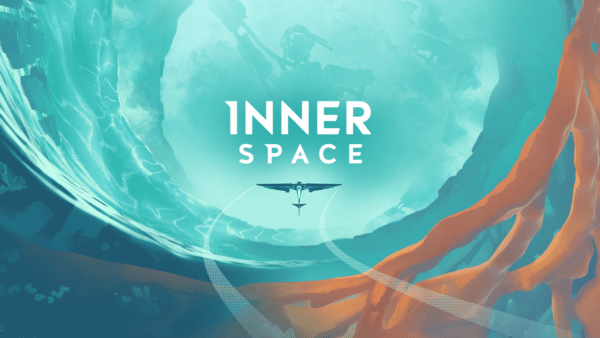Shaun Munro reviews InnerSpace…
InnerSpace is the debut effort from PolyKnight Games, a flight-exploration game which began development following a successful Kickstarter campaign back in 2014. While undeniably rough around the edges, the game’s enticing art-style, free-wheeling “do what you like” gameplay and ethereal musical score did nevertheless make most of my time with it both relaxing and enjoyable.
Like many indie exploration games, the setup is kept relatively vague and small portions of lore and world-building are instead doled out throughout the 4-6 hour campaign. InnerSpace is set within the Inverse, a world of inside-out planets that’s seeing out its final days, with the ambiguously-natured player character – who is never seen outside of their aircraft – tasked with helping out a submarine-like vessel known as the Archaeologist, to recover the scattered remnants of the Inverse’s civilisation before it’s all lost to time forever.
The bulk of the core gameplay entails entering a planet, flying around in your craft – both above ground and underwater – collecting trinkets called relics – there are almost 30 scattered throughout the game, each resembling a block of cheese, or perhaps a piece of Lego if you like – and finding your way to the Demigod hidden within each planet.
While a traditional game might hurl a boss fight at you here, not in this case, and in fact, you can’t even die in the game (collide with the environment too much and you’ll respawn back out in the open). After meeting each Demigod, you’ll briefly chat with them and be gifted a blue orb or two, which will in turn open up a new coloured ring you can use to travel to the next planet.
It might seem like a fairly repetitive loop, and if you’re planning to breeze through the game in one four-hour sitting, it probably will feel that way. However, InnerSpace is clearly made for those with a love of exploration.
While the worlds themselves aren’t huge, they’re curated with care and are mostly interesting to fly around even if you’re not working towards the core gameplay objective. Aside from just moving the story on, each world is littered with “wind”, white orbs which are effectively the world’s currency, and combined with the collection of relics, can be cashed in with the Archaeologist to unlock new “airframes” to navigate the planets.
If you love hoovering up collectables, this should scratch that itch pretty nicely, especially as many of the wind orbs are fiendishly hidden within tiny crevices you’ll most likely stumble upon by accident. And this, ultimately, is what will make InnerSpace an intermittent source of frustration for many players; the game’s relaxed, vague style actually makes it tough to figure out what the hell to do on occasion. While in fairness you can talk to the Archaeologist for a clue, he usually offers little in the way of a substantial hint, and on one occasion I found myself aimlessly flying around for upwards of an hour trying to figure out how to trigger the next Demigod.
There’s no on-screen map, which is definitely a good thing, but the nebulous, esoteric nature of some of the trigger-points do seem a little too devious for a game clearly intended to lower the player’s blood pressure rather than make it skyrocket. Thankfully, most of the time when you’re ready to move things along, it’s not too much of an effort, though PolyKnight might want to think about patching in more specific clues if the player keeps returning to the Archaeologist desperate for a nudge in the right direction.
The controls and camera also have their issues; some airframes handle horrendously no matter how you operate them, and though piloting most of the game’s aircrafts is easy enough, some more nuanced locomotion options wouldn’t go amiss. You may often find yourself colliding with environmental objects as you scramble to manoeuvre an airframe correctly, which in turn can force the camera to clip through the environment. For a game this visually imaginative, that’s awfully immersion-breaking.
Though in a textural sense InnerSpace won’t be blowing anyone away, the art style is really quite splendid, helping create a truly alien, otherworldly series of planets to navigate, perhaps best exemplified by the both majestic and intimidating Demigod creatures you come across throughout the game. Aurally, this is well-complimented by the electronic musical score, which can be played loud yet still resolutely chill players out.
While InnerSpace can be ploughed through in an afternoon, it is a game designed with the luxuriating gamer in mind, who will spend time flying around each planet, enjoying the sheer joy of flight, hoovering up coloured orbs, diving into every hidey hole they find, and after all that, eventually moving the plot forward. It’s a shame there’s not more to the narrative, because the brief, haunting moments that riff on the impermanence of everything are genuinely stirring, but by the time the end credits rolled, it felt like it culminated with something of a shoulder shrug. The cliche dictates that the journey is more important than the destination, and clearly, that’s very much the case here.
InnerSpace has its issues, absolutely, but it’s a solid indie exploration game, and if you’re a fan of the genre, you’ll probably find enough here to justify the asking price.
Pros:
+ Refreshingly hands-off explorative gameplay.
+ Sharp sound and visuals.
+ Enticing collectables present solid replay value.
Cons:
– Controls and camera could be better.
– Objectives can be frustratingly vague at times.
– Opaque narrative may irritate some.
Rating: 6.5/10
Reviewed for PS4 (also available on Xbox One, Nintendo Switch and PC).
Shaun Munro – Follow me on Twitter for more video game rambling.















